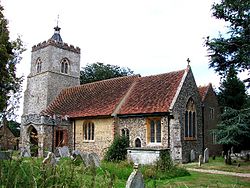Little Cornard
| Little Cornard | |
| Suffolk | |
|---|---|
 All Saints Church | |
| Location | |
| Location: | 52°1’5"N, 0°46’8"E |
| Data | |
| Population: | 286 (2011[1]) |
| Post town: | Sudbury |
| Postcode: | CO10 |
| Dialling code: | 01787 |
| Local Government | |
| Council: | Babergh |
Little Cornard is a village and parish in the Babergh hundred of Suffolk. Located around ½ mile from its larger sibling, Great Cornard, on the B1508 road between Sudbury and Colchester, it has a population of 305,[2] reducing to 286 at the 2011 Census. The parish also includes the hamlet of Workhouse Green.
The parish's eastern boundary is the River Stour (also Suffolk's border with Essex). The parish is also home to the Cornard Mere Site of Special Scientific Interest, and the Appletree Wood and Mumford Wood wildlife sites.
Church
All Saints Church is a small flint and brick church of the C14 and Cl5. Standing isolated in fields, it is a Grade I listed building.[3] There are six bells hanging in the tower, the oldest two were cast in 1399 and 1597, three were cast around the 1700s, and the sixth bell was newly cast during a restoration process in 2018.[4]
Hymn tune
The village also gives its name to a hymn tune by Martin Shaw, used for singing Charles E. Oakley's hymn Hills of the North, Rejoice[5] and for Lord of our Growing Years[6] by David Mowbray.
Dragon legend
There is a legend that on 26 September 1449 a fight between two dragons took place on a meadow by the River Stour. One dragon was black and came from Kedington Hill, Suffolk, the other was red and came from Ballingdon Hill, Essex. After an hour's fighting the red dragon won, and both went back to their hills. The site of the mythical battle is known locally as Sharpfight Meadow.[7]
References
- ↑ "Civil Parish population 2011". Neighbourhood Statistics. Office for National Statistics. http://neighbourhood.statistics.gov.uk/dissemination/LeadKeyFigures.do?a=7&b=11125680&c=Little+Cornard&d=16&e=62&g=6465513&i=1001x1003x1032x1004&o=362&m=0&r=1&s=1472048941392&enc=1. Retrieved 24 August 2016.
- ↑ Office for National Statistics : Census 2001 : Parish Headcounts : Babergh Retrieved 18 August 2010
- ↑ "CHURCH OF ALL SAINTS, Little Cornard 1181529". Historic England. https://historicengland.org.uk/listing/the-list/list-entry/1181529. Retrieved 10 April 2021.
- ↑ "All Saints Church". VCS Parish Church Websites. https://www.littlecornardchurch.org.uk/all-saints-church. Retrieved 9 April 2021.
- ↑ "Hills of the North, Rejoice". http://www.hymnary.org/text/hills_of_the_north_rejoice.
- ↑ "Lord of Our Growing Years". http://www.hymnary.org/text/lord_of_our_growing_years.
- ↑ Ash, Russell (1973). Folklore, Myths and Legends of Britain. Reader's Digest Association Limited. p. 241. ISBN 9780340165973.
Outside links
| ("Wikimedia Commons" has material about Little Cornard) |
- Little Cornard Vision of Britain
- All Saints Church Website All Saints Church website
- All Saints' Church Suffolk Churches
- Little Cornard Workhouse (Workhouse Green)